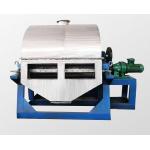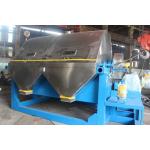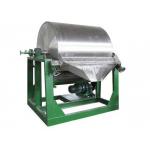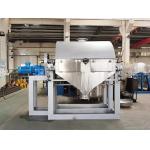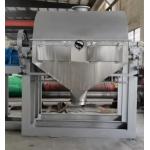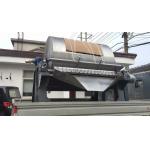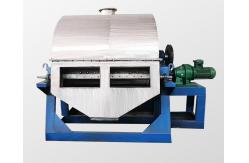Condensation Crystallization Slicer
Operating regulations
1. Before using the equipment, the feeding basin should be
preheated to avoid normal operation due to a solidified layer
between the material and the cylinder. Generally, it is enough to
keep the material warm until it becomes a liquid state.
2. The drum should be started before feeding, and the drum speed
can be adjusted to between 5-6 revolutions per minute.
3. After feeding, the drum speed can be adjusted according to the
slicing requirements, and the slicing output will be determined
according to the thickness and cooling effect.
4. Bags can be used to receive materials at the discharge port.
Product performance and features:
1. There are three feeding methods: upper feeding, rear feeding,
and lower feeding. According to the characteristics of chemical
materials, there are single drum type and double drum type.
2. The trough insulation includes steam insulation, thermal oil
circulation insulation, and electric heating insulation.
3. The equipment is divided into open type, semi-enclosed type,
fully enclosed type, vacuum type and nitrogen protection type.
4. Blade materials include brass, phosphor bronze, nylon, bakelite,
and alloy steel saw blades.
5. The discharging system has single discharging, double
discharging, etc.
6. Special requirements: The regular shape and size of the material
can ensure the uniformity of the thickness and size of the
material.
7. The cooling or (heating) system is divided into jacket type or
spray type. It is designed according to the size and specification
of the slicer and the characteristics of the material. It can
improve the heat exchange efficiency and increase the strength of
the drum, and increase the output of the relative product.
8. The cooling water adopts packing seal or rotary joint, which can
reliably prevent water leakage, and a new process is applied to
reduce the consumption of cooling water.
9. There are heat insulation layers and side scrapers at both ends
of the drum. There is no material build-up at both ends of the
drum, so there is no friction power consumption at both ends of the
drum, eliminating the problem of unstable startup due to material
build-up on the end surface.
Features
Performance reaches the level of modern foreign equipment
Continuously variable speed, adjustable drum speed
Equipped with side scrapers to avoid accumulation of material on
the side of the drum
High precision of rotating drum
The equipment has compact structure and small floor space.
Wide adaptability, easy and flexible operation
Half-pipe jacketed material tray, safe and reliable
Using multiple sets of scrapers, flexible adjustment
Spray water cooling, good cooling effect
Multifunctional, can be used for both flaking and drying
Specifications and models | Drum specifications
mm | Motor Power
KW | Slicing speedr/min Frequency Control | Reference dimensions mm | | L | W | H | | SQJ400| | 400×400 | 3 | 2-10 | 1350 | 800 | 1200 | | SQJ600I | 600×600 | 3-4 | 2-10 | 1550 | 1000 | 1400 | | SQJ600Ⅱ | 600×800 | 3-4 | 2-10 | 1750 | 1000 | 1600 | | SQJ800| | 800×800 | 4-5.5 | 2-10 | 1750 | 1200 | 1800 | | SQJ800Ⅱ | 800×1000 | 4-5.5 | 2-10 | 1950 | 1200 | 1800 | | SQJ1000I | 1000×1000 | 4-5.5 | 2-10 | 1950 | 1400 | 2000 | | SQJ1200| | 1200×1200 | 5.5-7.5 | 2-10 | 2200 | 1600 | 2200 | | SQJ1200Ⅱ | 1200×1500 | 5.5-7.5 | 2-10 | 2600 | 1600 | 2200 | | SQJ1500 l | 1500×1500 | 5.5-7.5 | 2-10 | 2600 | 1900 | 2400 | | SQJ1600| | 1600×1800 | 7.5-11 | 2-10 | 3000 | 2000 | 2500 | | SQJ1800 | | 1800×1800 | 11-15 | 2-10 | 3000 | 2200 | 2600 | | SQJ1800Ⅱ | 1800×2000 | 11-15 | 2-10 | 4200 | 2100 | 2600 | | SQJ2000 l | 2000×2000 | 11-15KW | 2-10 | 3700 | 2500 | 2800 | | SQJ2000Ⅱ | 2000×2500 | 15-18.5KW | 2-10 | 3700 | 3000 | 2800 | | SQJ2000 | 2000×3000 | 15-18.5KW | 2-10 | 4700 | 2400 | 2800 |
Application | Classification | Application Material Examples | | Organic maleic anhydride | paraffin, asphalt, caprolactam, p-nitrochlorobenzene, catechol,
p-dichlorobenzene, trimellitic anhydride, m-hydroxy,
1,8-diaminonaphthalene, diaminodiphenylmethane, N -Phenylmaleimide,
trimethylolpropane, polydiethanol, octylenediol Alcohol, polyethylene wax, polyvinyl acetate, TMP,
paraformaldehyde, dodecahydroxystearic acid, triphenyl phosphate
(TPP), MS, methyl chloride, etc. | | Inorganic types | sulfur, alkali sulfide, alkali, aluminum sulfate, calcium chloride,
caustic soda, sodium hydrosulfide, etc. | | Fine chemicals | 4010NA, 4020, RD, DTPD and other antioxidants; plasticizers such as
Aflux, Aktiplest, Z-80, plasticizer A, plasticizer B, RC series
organic cobalt salts, MOCA, leather treatment aids, surface Active
agents, plastic additives, rubber additives, organic palladium
salts, protective wax, etc. | | Oleochemicals | stearic acid and its salts, fatty acids (alcohols) and their salts,
glycerolipids, DMP-100, rosin glycerolipids, palm oil, etc. | | Resins | PF resin, tackifying resin, terpene resin, rosin resin, phenolic
resin, polymerized rosin, epoxy resin, polyamide resin, petroleum
resin C5-C9 | | Others | hot melt adhesive, emulsified explosives, gelatin, beeswax, sodium
phosphosilicate, thermosetting molding compounds, rubber and
plastic materials, vacuum kettle bottom materials, electronic grade
materials, DTPT, nitro-based fertilizers, nitrogen-based compound
fertilizers, PP |High concentration |
|
